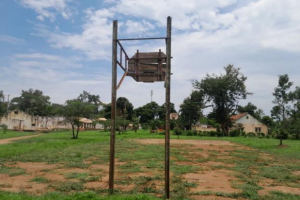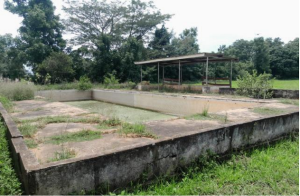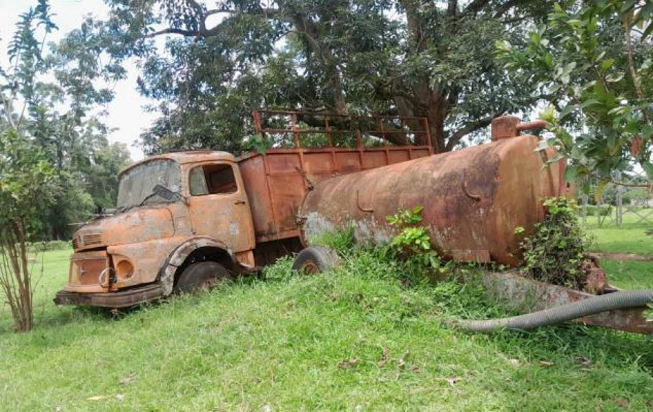The dilapidated service trucks in the school’s compound.
Trophies from various activities like netball, swimming, chess, and music competitions, along with other co-curricular activities, remain the only visible memoirs of Fr. Damian Grimes, a Catholic priest who transformed Namasagali College into a distinguished center of learning known for quality education across the East African region.

His demise on September 4th, 2024 brought the nation back to memory lane, tracing a legacy of quality education that shaped the careers and characters of many across the country.
The Kamuli-based Namasagali college was the epitome of a modern school during his time, boasting piped water pumped and filtered from the River Nile, as well as hydroelectric power, creating a conducive learning environment for the students.
The school’s main administration block, which housed many of Fr. Grimes’ memorable photos, was destroyed in a fire. The government is currently making efforts to restore this building. As a means of restoring Fr. Grimes’ legacy within the glorious walls of Namasagali, a home he cherished for more than three decades, former students have reinstalled his artistic portrait in the headteacher’s office, honoring the pinnacle of the school’s triumphant days.

The music room, opposite the school’s main administration block, still echoes the sounds of Fr. Grimes to his admirers, many of whom recall how he trained instrumentalists.
This room also served as a fashion exhibition area, where students actively participated in beauty contests, showcasing different cultures. Ronnie Orech, a former instructor of music, dance, and drama, who also served as the head of security from 1985 to date, says, for Grimes, the general outcome mattered more than academic grades.
Orech reminisces about how Namasagali was a prominent name at the national theatre, with hundreds of students presenting unique forms of art, from music and poetry to ballet dances and paintings, leaving no room to be outcompeted by any other school. Orech notes that under Fr. Grimes’ leadership, every student was expected to participate in sporting and MDD (Music, Dance, and Drama) activities while excelling academically.

With a hint of sadness, Orech expresses dismay over the decline of Namasagali, which he viewed as a beacon of hope for nurturing responsible citizens equipped with the leadership skills to succeed in any sector globally. He recalls that Fr. Grimes left Namasagali with a student enrollment of 1,800 in 2000, but 24 years later, the number dropped to less than 600.
Orech further reveals Fr. Grimes’ conservation efforts, noting how he ensured the planting of trees as safe havens for monkeys, a legacy that remains a living tale at Namasagali College.
Fred Bogere narrates his career growth from a gardener in 1970 to a headman from 1971 to 1999, a role that endeared him to Fr. Grimes as he represented the interests of all casual laborers at the school. Bogere says that Fr. Grimes was quick to address their concerns, and his departure led to a drastic decline, as the government leadership lacked the lobbying skills necessary to attract foreign funding, which had largely sustained the school’s operational budget.
Paul Kiwanuka recalls how it dawned on him in 2000 that it was the last time he would drive Fr. Grimes, a man who had given him a decent life despite his initial illiteracy. Kiwanuka recounts how Fr. Grimes, while walking around Namasagali village, jokingly employed him as a driver, despite his inability to express himself in English.
“All I knew were about three phrases: ‘how are you,’ ‘come here,’ and ‘you are welcome.’ But Fr. Grimes literally taught me to speak English in about four months, and I was able to express myself before his entourage without his intervention,” he says.

Kiwanuka also narrates how, at the end of every month, Fr. Grimes would transport all his workers to Jinja town to purchase goods at affordable prices.
Outside the college gates, Fr. Grimes was a beacon of hope for the residents of Namasagali sub-county, always ready to help anyone in need.
Maliza Nangobi, a resident of Bwiiza village, now aged 72, recalls how Fr. Grimes offered her farming space and shelter after her children and husband were killed during the unrest in 1985. He also dispatched Catholic nuns to provide her with counseling for close to a year, allowing her to remarry in the early 1990s.
Fred Balyejusa, a former meals supervisor at Namasagali College, says that Fr. Grimes instructed them to distribute regular meals to members of the general public, which greatly endeared him to the surrounding communities.
Moses Waiswa, a senior citizen in the area, says that Namasagali College was a first-class school. Recognizing that local residents could not afford it, Fr. Grimes introduced a bursary scheme for ten pupils annually.
Waiswa recalls how Fr. Grimes encouraged his parents to relocate him from Jinja SSS, which was charging tuition fees of 450 shillings, to Namasagali College, where the fees were 150,000 shillings, after hearing reports of his academic performance.
Waiswa also mentions that Fr. Grimes provided free medical care to neighboring communities, along with weekly hampers of powdered milk, rice, and posho to the most impoverished individuals, whose particulars were regularly submitted by local leaders.
Situated on an estimated 1,000-acre piece of land along the banks of the River Nile in Kamuli district, Namasagali College became a center of excellence. This transformation was due to a resolve by the then Busoga government to convert the defunct Busoga Line main station into a secondary school, which they entrusted to the leadership of the Mill Hill Fathers.
Fr. Grimes took up the school’s leadership in 1967, introducing holistic educational modules that prioritized discipline while encompassing both academic excellence and talent promotion among learners.
This education format shaped students’ lives across Uganda and the entire East African region, with education enthusiasts at the time choosing Namasagali as the center of learning for their children.
Despite the current decline at Namasagali College, the unique teaching methodologies of Fr. Grimes remain a clear testament on the lips of those who experienced his goodness. To many, Fr. Grimes was a disciplinarian and an advocate of holistic education, incorporating co-curricular activities and MDD as a compulsory aspect for every student. This prompted families to choose the seemingly rural Namasagali-based school as a knowledge hub for their children.
The once prestigious school, which attracted individuals from various spheres of life who braved the gully-filled 21 km stretch from Kamuli town in search of quality education, is now a shadow of its former self. Not even the now-improved roads can restore her former glory.
Many, however, remain hopeful that the return of Fr. Grimes’ remains, which they hope to lay to rest in the area, will rekindle the spirit of the once vibrant Namasagali College, awakening the echoes of its swimming waters and reigniting the now-silent Namasagali theatre to release its sounds of hope once more.
-URN






Am humbled to be part of this group
Correction: It is the Namasagali Alumni that is steadily restoring the school buildings by building new ones, including the new administration block. Not the government. Thank you.